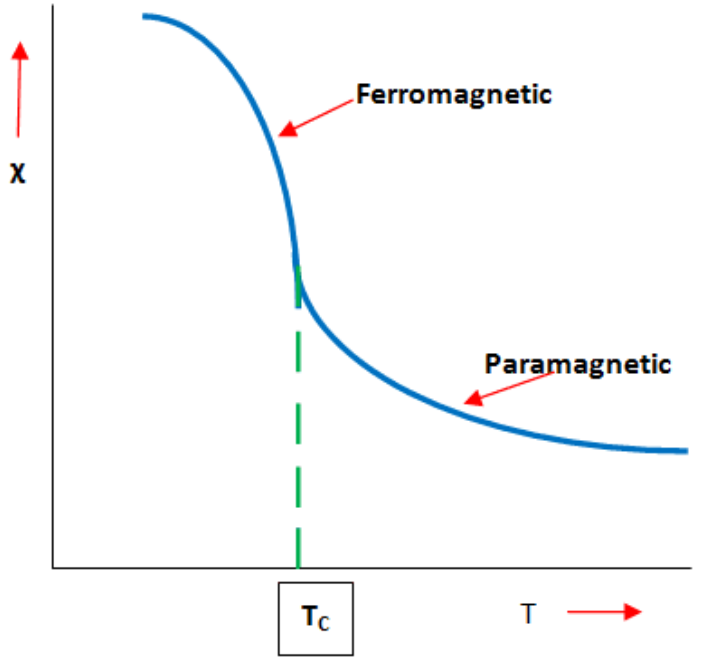
What is Curie temperature?
Answer
536.1k+ views
Hint: Before understanding Curie temperature, we must know that, as temperature increases, the randomization of magnetic moments increases. This results in changes in properties of magnetic materials. Curie temperature is such a point.
Complete solution:
Now we will discuss more about Curie temperature and temperature dependence on susceptibility of materials.
Curie temperature: it is the temperature at which a ferromagnetic material becomes paramagnetic in nature. That is, the temperature at which a magnetic material completely loses its magnetic property.
When temperature increases, randomization of magnetic moments increases which leads to decrease in magnetization \[I\]. So, the resulting magnetic field \[B\] decreases.
That means \[\chi \](susceptibility) decreases as \[T\] increases.
Curie's law states that “susceptibility of a paramagnetic substance is inversely proportional to temperature.”
i.e., \[\chi =\dfrac{c}{T}\]
In this equation, \[c\] is called Curies constant.
Now, let’s take the case of a ferromagnetic material. A ferromagnetic material has magnetic properties as its magnetic moments are aligned in a certain direction. As temperature increases, this alignment randomizes and it loses magnetic property and turns into a paramagnetic material at a certain temperature. This temperature is known as Curie temperature.
After Curie temperature, we can see the susceptibility varies as, \[\chi =\dfrac{c}{T-{{T}_{C}}}\]
Where \[{{T}_{C}}\] is a Curie temperature.

Note: We must be aware that every material has different construction of intrinsic magnetic moments that depend on temperature. So Curie temperature varies according to materials as temperature required for different materials differs.
Complete solution:
Now we will discuss more about Curie temperature and temperature dependence on susceptibility of materials.
Curie temperature: it is the temperature at which a ferromagnetic material becomes paramagnetic in nature. That is, the temperature at which a magnetic material completely loses its magnetic property.
When temperature increases, randomization of magnetic moments increases which leads to decrease in magnetization \[I\]. So, the resulting magnetic field \[B\] decreases.
That means \[\chi \](susceptibility) decreases as \[T\] increases.
Curie's law states that “susceptibility of a paramagnetic substance is inversely proportional to temperature.”
i.e., \[\chi =\dfrac{c}{T}\]
In this equation, \[c\] is called Curies constant.
Now, let’s take the case of a ferromagnetic material. A ferromagnetic material has magnetic properties as its magnetic moments are aligned in a certain direction. As temperature increases, this alignment randomizes and it loses magnetic property and turns into a paramagnetic material at a certain temperature. This temperature is known as Curie temperature.
After Curie temperature, we can see the susceptibility varies as, \[\chi =\dfrac{c}{T-{{T}_{C}}}\]
Where \[{{T}_{C}}\] is a Curie temperature.

Note: We must be aware that every material has different construction of intrinsic magnetic moments that depend on temperature. So Curie temperature varies according to materials as temperature required for different materials differs.
Recently Updated Pages
Physics and Measurement Mock Test 2025 – Practice Questions & Answers

NCERT Solutions For Class 5 English Marigold - The Little Bully

NCERT Solutions For Class 12 Maths Three Dimensional Geometry Exercise 11.1

NCERT Solutions For Class 11 English Woven Words (Poem) - Ajamil And The Tigers

NCERT Solutions For Class 6 Hindi Durva - Bhaaloo

NCERT Solutions For Class 12 Physics In Hindi - Wave Optics

Trending doubts
Which are the Top 10 Largest Countries of the World?

Differentiate between homogeneous and heterogeneous class 12 chemistry CBSE

Why is the cell called the structural and functional class 12 biology CBSE

a Tabulate the differences in the characteristics of class 12 chemistry CBSE

Who discovered the cell and how class 12 biology CBSE

Draw a labelled sketch of the human eye class 12 physics CBSE




